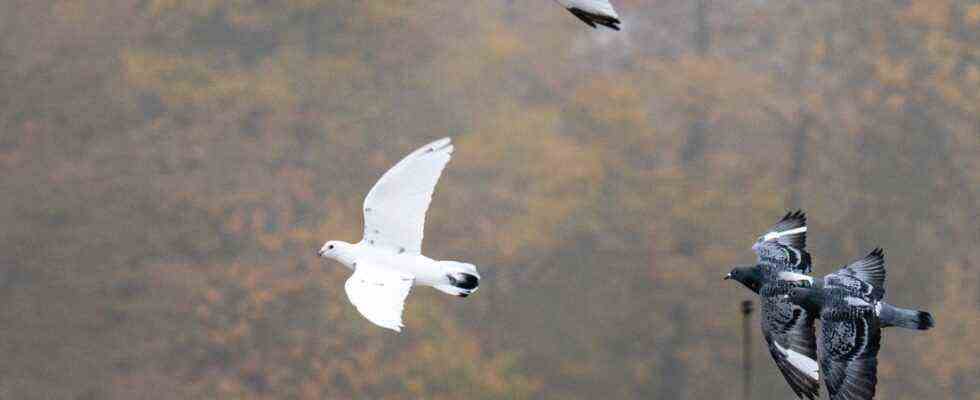A flock of pigeons does a few laps above the University of Regensburg. Then the birds flutter into an aviary on the roof, little by little all the pigeons return. The animals live here, are looked after and no longer nest wildly in underground garages or on projecting windows.
In 2012, after decades of trouble with pigeon droppings, the university started a project to contain the pigeon plague – the “Regensburg Model”. With success, as a spokesman for the university now says: “The pigeon colonies that caused problems in the past have been dissolved.” Pigeon expert Ferry Wittke from Bad Abbach in Lower Bavaria has specially bred a special type of decoy pigeon that is used to tame feral city pigeons. Together with his business partner Frank Wilm from Baldham near Munich, he once tried out his “Regensburg model” on the university roof.
Today 50 to 80 pigeons live in two aviaries. Otherwise the university area is free of pigeons – apart from a few “infirmaries”. These are not a problem, after all, a pair of hawks lives on the university campus and every now and then catches a pigeon. For the pigeons, the dovecotes are downright luxury residential complexes. Here they are protected from wind, rain, snow and predators. There is species-appropriate food, fresh water and bathing facilities as well as niches for nesting. Eggs are exchanged for artificial eggs by the operators of the facility, so that the pigeons can breed but cannot reproduce. Only now and then is a pair of pigeons allowed to hatch their eggs in order to have a sense of achievement. Eggs removed are sent to zoos and fox rearing stations for feeding.
With the help of the so-called decoy pigeons that Ferry Wittke bred, feral city pigeons are to be tamed.
(Photo: Armin Weigel / dpa)
The decoy pigeons have a reddish-beige color, which makes them interesting for city pigeons. The male decoys charm the females with distinctive cooing sounds and the female decoys are not only monogamous, but also very relaxed, as Ferry Wittke explains. In any case, his breeding pigeons successfully lured the city pigeons into the loft. “The decoy pigeons teach the city pigeons to eat with a knife and fork,” says Wittke. The city pigeons quickly came to appreciate the convenience of the new housing and instead left their previous nesting sites. After regular free flights, the animals voluntarily returned to the dovecote and sometimes brought newcomers with them.
From the point of view of the university, the model with the relocation from the campus to the dovecotes should be regarded as “permanently successful”, says Martin Postner from the university’s environmental protection department. “We are very proud of the implementation of the concept because it pursues a holistic approach that takes animal behavior into account and, of course, animal welfare.” This is a particular concern of the duo Wittke and Wilm. You don’t just want to take action against pigeon plagues, but also against cruelty to animals. He has seen too many nasty things that homeowners have done to pigeons – pour boiling water over nests or downright butcher the animals with a knife. “Does that have to be?” Asks Wittke. And because he understands that house owners are annoyed by pigeon droppings, he offers a solution with his “Regensburg model”, how the animals can be decimated gently.
Since there have been pigeon houses, the number of animals on Augsburg Town Hall Square has decreased significantly
The project will also be implemented in other cities. Also known is the “Augsburger Modell”, which is designed similarly to the Wittkes, but without decoy pigeons and with open pigeon houses. According to Wittke, the advantage of the closed pigeon house is that pigeons cannot simply help themselves to the food and then return to their traditional nesting place outside. In Augsburg, for example, the number of pigeons on Rathausplatz has fallen significantly since the dovecotes were built, says a spokeswoman for the Augsburg Animal Welfare Association. Here, too, the pigeon eggs are exchanged. The spokeswoman considers it necessary to let the animals hatch eggs once a year so that the pigeons do not leave the loft due to a lack of successful breeding and look for another place to nest again.
In the city of Munich there are 20 pigeon houses based on the “Augsburg model”, as the pigeon commissioner Reinhard Bodisch says. Three more locations are being planned. There are subsidies for homeowners who want to build a dovecote on their roof. The need for more dovecotes is particularly great in the city center. However, it is not easy to win homeowners for it. In some cases it is simply not possible for structural or static reasons to build a dovecote on or on a house.
How many pigeons flutter through the state capital is difficult to estimate. In 1991 there was a study according to which 40,000 copies lived in Munich. Bodisch assumes that there should be around 60,000 pigeons today. There is currently a call for tenders for a new study to be used to calculate the number. A problem for the municipalities are animal lovers who feed pigeons, although this is not necessary and sometimes forbidden, says Bodisch. There are “very special pigeon friends” who fear that the pigeons will starve to death and then go out at night to spread food. This is particularly problematic in the vicinity of pigeon lofts, because the pigeons then do not find it necessary to move into the pigeon house.

